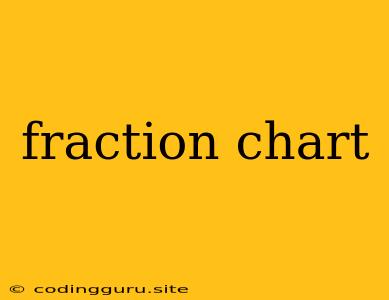Understanding Fraction Charts: A Visual Guide to Fractions
Fraction charts are powerful tools used to visualize and understand fractions in a simple and engaging way. Whether you're a student learning about fractions for the first time or a teacher looking for a visual aid to enhance your lessons, fraction charts offer a clear and intuitive approach to grasping fractional concepts.
What are Fraction Charts?
A fraction chart is essentially a visual representation of a whole divided into equal parts. Each part represents a specific fraction of the whole. Typically, a fraction chart is displayed as a rectangle or a circle divided into segments, with each segment labeled with its corresponding fractional value.
Why are Fraction Charts Useful?
- Visual Representation: Fraction charts provide a concrete visual representation of fractions, making them easier to understand and relate to real-world scenarios.
- Comparing Fractions: Charts allow for easy comparison of different fractions by visually seeing their sizes relative to the whole. You can instantly determine which fraction is larger or smaller.
- Equivalent Fractions: Fraction charts can be used to demonstrate equivalent fractions by visually showing how different fractions represent the same amount of the whole.
- Fraction Operations: Charts can be used to visualize adding, subtracting, multiplying, and dividing fractions.
Types of Fraction Charts:
- Linear Fraction Charts: These charts display fractions as a continuous line divided into equal segments, making it easy to visualize the relationship between different fractions.
- Circular Fraction Charts: These charts depict fractions as sections of a circle, offering a visual representation of how fractions relate to the whole circle.
- Fraction Walls: Fraction walls are multi-level charts that display a range of fractions, from unit fractions to mixed numbers, providing a comprehensive overview of fractional concepts.
How to Use Fraction Charts:
- Identify the Whole: Begin by clearly understanding what the whole represents in the chart. Is it a whole pizza, a whole cake, or a whole unit?
- Divide the Whole: The chart is divided into equal parts, each representing a specific fraction of the whole.
- Label the Parts: Each part of the chart is labeled with its corresponding fractional value, helping to solidify the connection between the visual representation and the numerical fraction.
- Compare and Contrast: Use the chart to compare and contrast different fractions, observing their sizes and relationships.
- Explore Equivalent Fractions: Identify different sections of the chart that represent the same amount of the whole, highlighting the concept of equivalent fractions.
Examples of Fraction Charts in Action:
- Comparing 1/2 and 1/4: A fraction chart with the whole divided into four equal parts would show that 1/2 is equivalent to two of the 1/4 parts, making it visually clear that 1/2 is larger than 1/4.
- Adding Fractions: To add 1/3 + 1/6, a fraction chart with the whole divided into six parts can be used. You would visually see that 1/3 is equivalent to two of the 1/6 parts, and adding these together gives you a total of 3/6, or 1/2.
Tips for Creating Your Own Fraction Chart:
- Start with Simple Fractions: Begin with charts that depict simple fractions, such as halves, thirds, and fourths.
- Use Different Colors: Employ different colors for each segment of the chart to enhance visual differentiation.
- Make it Interactive: Allow students to manipulate the chart, moving segments or highlighting different parts, to encourage hands-on learning.
- Real-World Connections: Connect the fraction chart to real-world objects and scenarios to make the concept more relatable.
Fraction Charts: A Visual Aid for Learning
Fraction charts provide a valuable visual aid that makes learning about fractions engaging and intuitive. They are a powerful tool for understanding the relationships between fractions, comparing their sizes, and exploring concepts like equivalent fractions and fraction operations. By using fraction charts in the classroom, you can help students build a strong foundation in fractions, leading to greater confidence and success in their math journey.
Conclusion:
Fraction charts are a valuable resource for teachers and students alike, providing a visual and interactive way to learn about fractions. By offering a clear representation of fractional concepts, fraction charts can help individuals of all ages build a strong understanding of this fundamental mathematical concept. Whether used for teaching, self-learning, or reinforcing understanding, fraction charts are a powerful tool for demystifying fractions and making them accessible to everyone.
